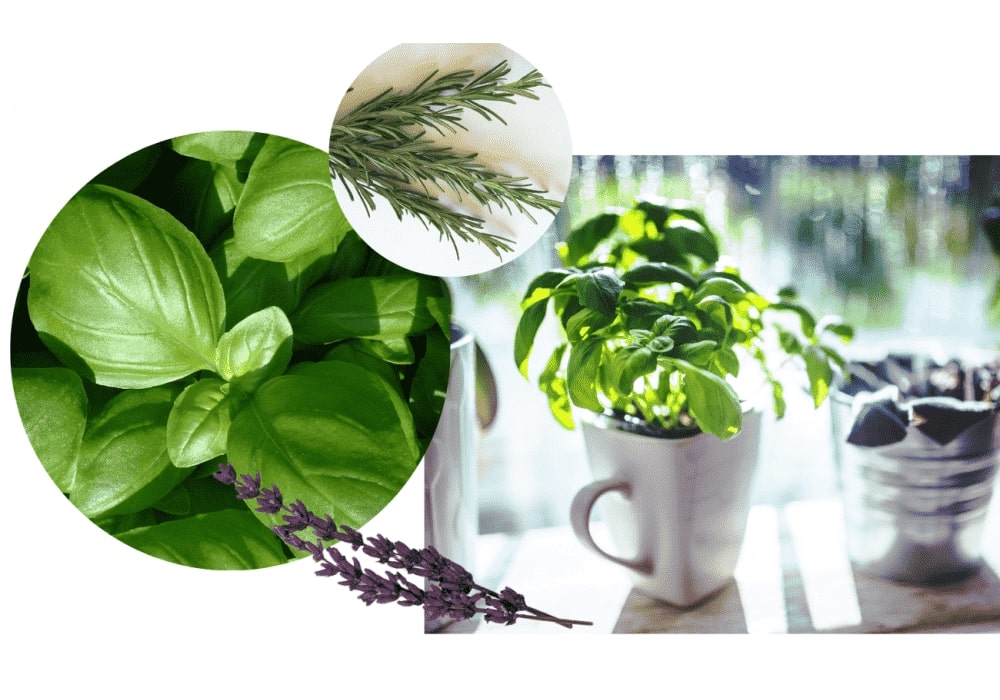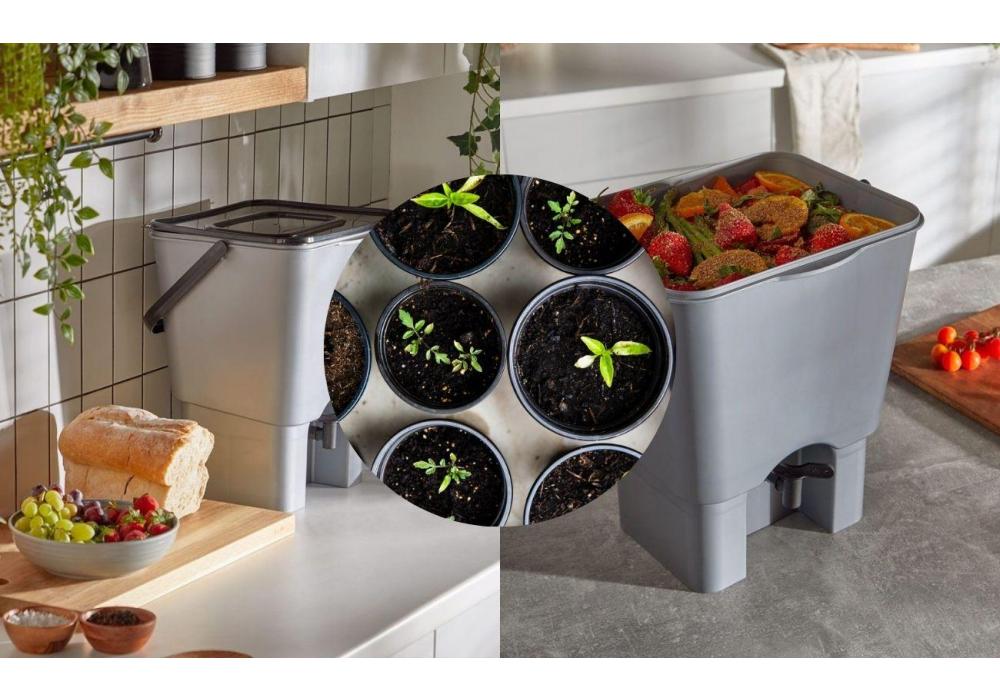The Easiest Herbs To Grow Indoors
Herbs are an essential cooking staple, ideal for adding depth and intensity of flavour to your food and drinks. But did you know just how easy it is to start growing herbs indoors, from the comfort of your own kitchen? In this article, we’ve outlined how to grow herbs at home, as well as the easiest herbs to grow indoors.


How to grow herbs indoors
If you’re not used to looking after plants, you might feel unsure about where to start when growing herbs indoors. Fortunately, we’ve outlined how to grow and look after your indoor herb plants, and offered top tips to help you along the way!
1. Use containers with good drainage
Before you can start growing your own herbs, it’s important to ensure your pots have suitable drainage, to prevent your soil from becoming waterlogged and your herbs dying. To avoid waterlogging, simply plant your herbs in containers that have a series of holes towards the base. These allow water to run through the soil organically, and prevent pooling.
Top tip: We recommend that you keep your herb pots in a second container to catch all the excess water – or else you run the risk of making a mess of your windowsill or countertop! Perhaps consider a container that matches your kitchen aesthetic, like stylish glass storage or jars.
2. Choose a suitable soil
Growing herbs inside means you need to replicate the nutrient-rich quality of the soil in your garden. A sandy consistency is ideal, as it allows water and moisture to filter through efficiently.
Top tip: Hydroponic herbs (those grown without soil) typically grow quicker than those planted in soil. If you’re creating an indoor hydroponic herb garden, just make sure your roots are submerged in nutrient rich water.
3. Pick a sunny windowsill
When growing herbs indoors, you’ll need to manage the amount of light and warmth your pots and planters receive. The easiest way to achieve this is to place your herbs on a south facing windowsill.
Top tip: Growing herbs indoors without sunlight? If you don’t have a south facing windowsill, or are struggling to give your herbs sufficient sun in the winter months, don’t worry; you’ll still be able to enjoy your favourite herby flavours. Get around the lack of natural light by placing your pots beside fluorescent bulbs, to boost exposure.
4. Don’t overwater your herbs
While herbs require water to flourish, it’s important to ensure your pots aren’t overfilled. This limits the supply of oxygen to the roots, which makes it more difficult for your plants to grow.
Top tip: As a rule of thumb, water your indoor herb plants when the soil looks like it’s starting to dry out.
5. Take little and often
To keep your windowsill herbs regrowing at a steady rate, make sure not to take or trim too much at once. Instead, simply pinch a couple of leaves or sprigs at a time.
Top tip: Taking regularly from your indoor herb plants will encourage quicker growth. Even if you’re not using the leaves in the moment, harvest them and keep them in the freezer for later.
What are the easiest herbs to grow indoors?
Now you know the basics of growing and looking after windowsill herbs, it’s time to pick your favourites. We’ve outlined 10 of the easiest herbs to grow indoors to give you a little inspiration.
Basil
A versatile herb, basil is a popular addition to many Italian dishes, as well as being a base ingredient of green pesto. Basil is one of the most straightforward windowsill herbs to maintain, so long as you expose it to bright light, heat, and nutrient-rich soil, and keep your pot away from draughty, open windows. To regrow more basil, continue to plant seeds every 2-4 weeks.
Oregano
A great addition to tomato sauces, soups, and stews, oregano is best-grown in strong light and requires watering as and when your soil looks like it’s starting to dry out. When ready to use, strip the oregano leaves from the stems, and, to regrow more oregano, simply plant your stem tips.
Coriander
Commonly found in Indian, Asian, and Middle Eastern dishes, coriander, sometimes referred to as cilantro, is sure to become an essential addition to your indoor kitchen herb garden. Like other indoor herb plants, coriander grows best in bright sunlight, and you’ll need to ensure soil is consistently moist.
Parsley
Parsley is often used in fish, chicken, and vegetable dishes, and adds bright and inviting colour to your soups and salads. Among the fastest-growing herbs, taking just 2-3 weeks to regrow, parsley is a great addition to any indoor kitchen herb garden – just make sure you have a lot of strong lighting!
Rosemary
Beautifully fragrant, rosemary needles can immediately elevate your lamb, pork, or chicken, or add depth to your soups and sauces. The herb also gives you a gorgeously aromatic kitchen as you cook over the chilly winter months! It’s worth noting that rosemary grows well in an indoor hydroponic herb garden and doesn’t necessarily require soil nutrients – just strong lighting and good drainage.


Thyme
Versatile and flavourful, thyme is a core ingredient in countless dishes worldwide and a regular addition to stews, soups, and roasts. Thyme doesn’t require too much attention to thrive, but you will need to water regularly and keep your pots in strong sunlight.
Mint
Mint is a popular addition to salads, sweet treats, and cocktails. Amazingly fresh, fragrant, and fast-growing, mint makes the ideal pot partner for your other indoor herb plants. And as is the case with many windowsill herbs, mint doesn’t take much care beyond a bright spot and plenty of water.
Sage
Mimicking a peppery and flavourful forest, you’ll recognise sage by its thick and fragrant foliage. Often used to add aroma to sausages, vegetables, and even buttery sauces, sage is sure to prove a strong addition to your selection of indoor herbs plants.
Lavender
Brightly coloured and enchantingly aromatic, lavender has become a much-loved herb of choice for its inviting floral fragrance; it’s scent is even known to reduce stress and anxiety, so it’s worth adding to your herb garden for the calming influence alone. That said, lavender can also be used to add great depth of flavour to your coffee, cooking, and cocktails.
Tarragon
Fresh, aromatic, uniquely flavoured, similar to fennel, anise, or liquorish, tarragon is often used to enhance dressings, sauces, and marinades; simply snip from the stem and pluck the leaves. For maximum growth, cut back little and often, to encourage bushing.
Flavourful and fragrant, herbs add depth to food, sauces, and drinks. Even better; many can be grown from the comfort of your own kitchen. Discover what you need to started on your own windowsill herb garden, or explore our blog for even more foody inspiration.





 Need help?
Need help?

